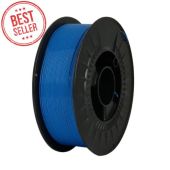Tips for Handling and Choosing the Right 3D Printing Filament
Before diving into specific filament types and printing tips, it's important to start with the basics of filament handling. Proper loading and unloading prevent hardware issues and wasted material. Removing filament properly helps extend the life of your 3D printer and ensures smooth transitions between materials.
How to Remove Filament from 3D Printer
Here are the correct steps:
- Preheat the Nozzle
Always bring the hotend up to the filament's regular printing temperature, or about 20°C below that point. Pulling filament while cold risks breaking it or damaging internal components. - Use the Printer’s Built-in Controls
Most 3D printers offer a built-in "Unload filament" or "Retract" option. This will heat the nozzle automatically, reverse the extruder motor, and allow for clean removal. - Manual Unload Process
If your printer doesn’t include that feature, release the extruder tension manually. Once heated, gently push the filament until a bit extrudes, then steadily pull it out. Don’t yank—the filament end may be slightly flared from heat. - Use Another Filament to Assist (Cold Pull or Purge)
When dealing with stuck or short pieces:
• Heat the nozzle.
• Insert another filament with equal or lower melting temperature.
• Push it in to purge the jammed filament.
• Alternatively, try a cold pull: heat slightly, let it cool just below the glass transition temperature, and pull out residue and debris. - Protect Your Equipment & Reduce Waste
Improper removal can mix materials, leave clogs, or waste filament. Always aim for a clean, angled tip. Cut it at a 45° angle and straighten any curling before inserting new filament.
3D Filaments for Engineers, Designers & Makers — The Full Collection at 3DTrcek
The right filament is the foundation of a successful 3D print. At 3DTrcek, the catalog includes carefully selected materials for demanding use cases. Whether you're prototyping, designing end-use products, or building functional mechanical parts, there's a match for your needs.
PLA and PLA+ for Everyday Prints
PLA is the go-to filament for beginners and experienced users alike. It prints at low temperatures, doesn’t require a heated bed, and delivers smooth finishes. PLA+ enhances toughness and print detail, making it suitable for presentation models and artistic designs.
PETG for Durable and Water-Resistant Parts
PETG combines the ease of PLA with added strength and chemical resistance. It’s great for mechanical parts, enclosures, or anything exposed to moisture. The low warping and reliable layer adhesion make PETG a versatile filament in any workshop.
ABS and ASA for Tougher Jobs
ABS remains a standard in industrial applications for its impact resistance and post-processing flexibility. ASA offers similar mechanical properties with added UV resistance, making it ideal for outdoor parts. These filaments require an enclosed printer due to shrinkage and fumes.
TPU for Flexible Components
TPU is a soft, rubber-like filament ideal for prints that need elasticity, such as gaskets, phone cases, or vibration dampeners. With careful tuning, it can run smoothly on most direct drive systems. Print speeds should be reduced to ensure accurate flow and dimensional stability.
PAHT CF for High-Performance Parts
PAHT CF (high-temperature nylon with carbon fiber reinforcement) offers exceptional stiffness and thermal stability. It’s engineered for demanding use cases like functional prototypes, automotive brackets, or structural parts. This filament needs higher printing temperatures and proper drying.
Special Purpose Filaments
For specific applications, 3DTrcek also provides materials like:
- Wood-filled PLA for decorative prints
- Conductive filament for low-voltage electronics
- Metal-filled filaments for a metallic finish
- Glow-in-the-dark variants for visual effects
Each filament has unique handling needs. For instance, some absorb moisture quickly and must be stored in airtight containers or dried before printing.
Tips for Filament Storage and Handling
- Keep dry: Use sealed bags or dry boxes with silica gel
- Label your spools: Identify material type and printing temps
- Use filament guides or buffers: Prevent tangling and reduce drag
- Clean nozzles between changes: Avoid cross-contamination between materials
These steps reduce print failures, save material, and maintain consistent output quality.
Why Filament Quality Matters
Low-grade filament can cause nozzle jams, inconsistent extrusion, poor layer adhesion, and visual defects. Diameter consistency, material purity, and proper winding all play a role. That’s why 3DTrcek stocks only tested and verified brands.
Common Issues with Poor Filament:
- Under- or over-extrusion due to inconsistent diameter
- Warping or weak layers from moisture absorption
- Brittle prints from contaminated base materials
Investing in better filament upfront often means fewer reprints and less machine wear.
Final Thoughts
Choosing the right filament and learning how to handle it correctly will dramatically improve your 3D printing results. From storage to printing to removal, each step affects the final product.
3DTrcek’s selection covers everything from common PLA to high-performance composites. If you're building architectural models, machine parts, or artistic prints, selecting the right filament is essential.
Take care of your materials, use the correct settings, and always remove filament properly to keep your machine running at its best.
; ?>) Shop Filaments
Shop Filaments


Please complete your information below to login.
Bejelentkezés
Új fiók létrehozása